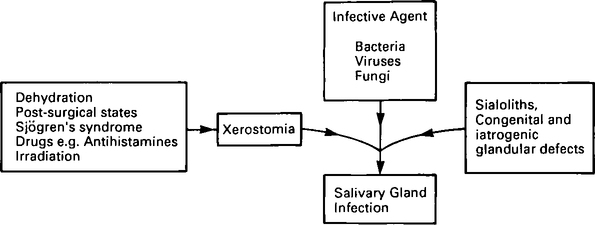Salivary gland infections
Publisher Summary
Salivary gland infections are not uncommon. The most frequently encountered infection of the salivary glands is caused by the mumps virus. However, a number of other agents, particularly bacteria, are responsible for acute sialadenitis. The parotid glands are more commonly infected than the submandibular salivary glands and most reports deal with bacterial parotitis, although the submandibular glands might be similarly affected. Infections of the accessory salivary gland can occur but are rare. Apart from mumps, the majority of salivary gland infections are seen in adults. However, there are two rather ill-defined clinical entities termed “neonatal suppurative parotitis” and “recurrent parotitis of childhood” that are confined to the first decade of life. As in other infectious diseases, initiation and progression of salivary gland infections would appear to depend on the host resistance to infection and the virulence of the causative organism. The decrease in host resistance in the present context could be either because of general factors such as debility and dehydration or local factors including sialolithiasis, ductal strictures, and salivary gland pathology.
The parotid glands are more commonly infected than the submandibular salivary glands and consequently most reports deal with bacterial parotitis, although the submandibular glands may be similarly affected. Infections of the accessory salivary gland can occur but are very rare (Table 11.1). Apart from mumps, the majority of salivary gland infections are seen in adults. However, there are two rather ill-defined clinical entities termed neonatal suppurative parotitis and recurrent parotitis of childhood (chronic juvenile parotitis) which are confined to the first decade of life.
Table 11.1
Classiflcation of salivary gland infections
| Type of infection | Gland usually affected | Predisposing factor(s) |
| Mumps (endemic parotitis) | Parotid | No prior exposure to virus |
| Acute suppurative parotitis | Parotid | Severe xerostomia (e.g. Sjögren’s syndrome), localized and diffuse abnormalities of the salivary glands |
| Obstructive sialadenitis | Submandibular | Sialolith, foreign bodies, ductal strictures, mucus plugs |
| Suppurative and chronic recurrent parotitis of childhood | Parotid | Congenital or acquired abnormality of ductal system |
| Rare miscellaneous disorders, e.g. tuberculosis, actinomycosis and fungal infections | Parotid or submandibular | Systemic infection by specific agents, e.g. M. tuberculosis |
As in many other infectious diseases, initiation and progression of salivary gland infections would appear to depend on the host resistance to infection and the virulence of the causative organism(s). The decrease in host resistance in the present context could be either due to general factors such as debility and dehydration or due to local factors including sialolithiasis, ductal strictures and salivary gland pathology. Factors important in salivary gland infections are shown in Figure 11.1.
Stay updated, free dental videos. Join our Telegram channel

VIDEdental - Online dental courses



